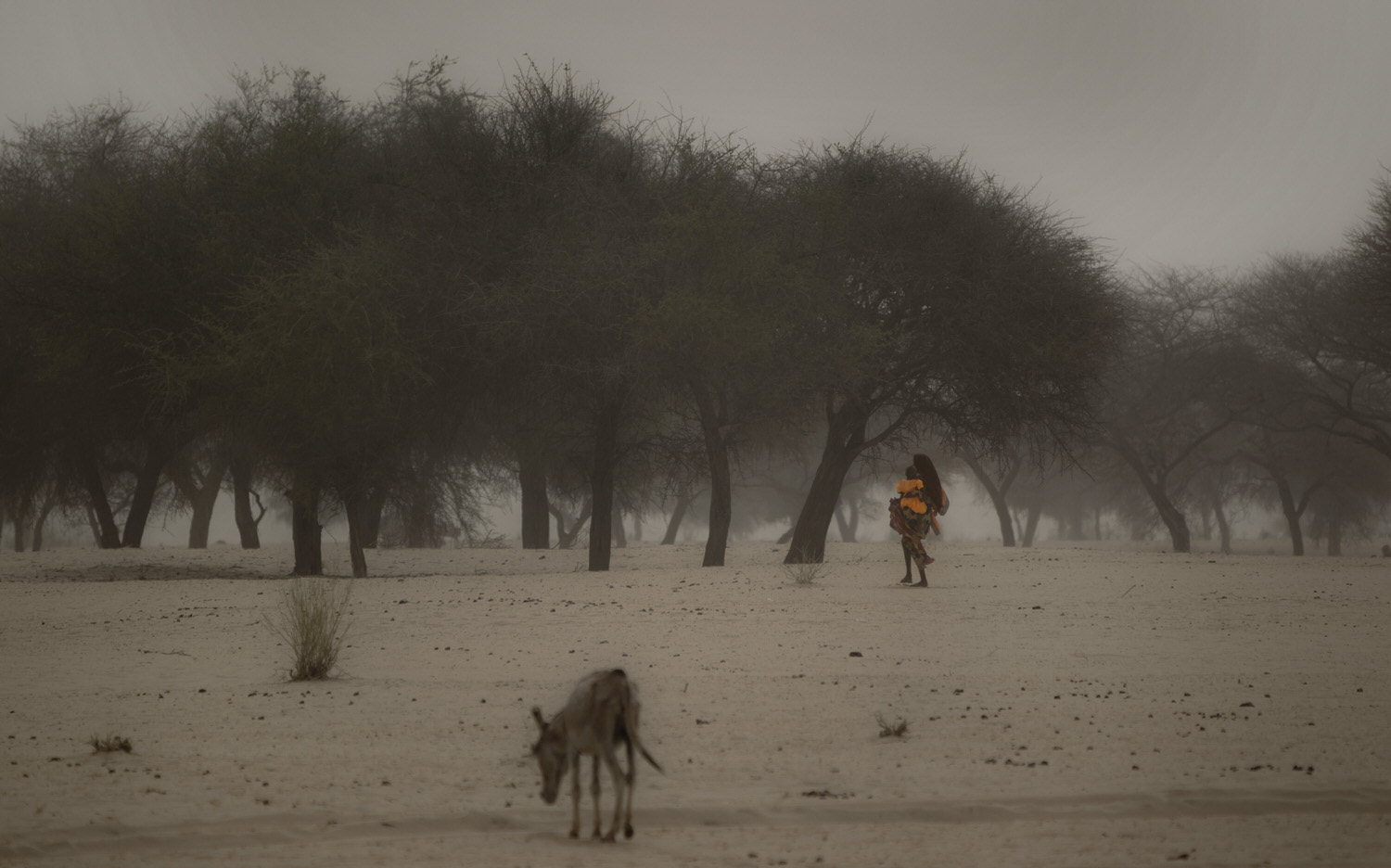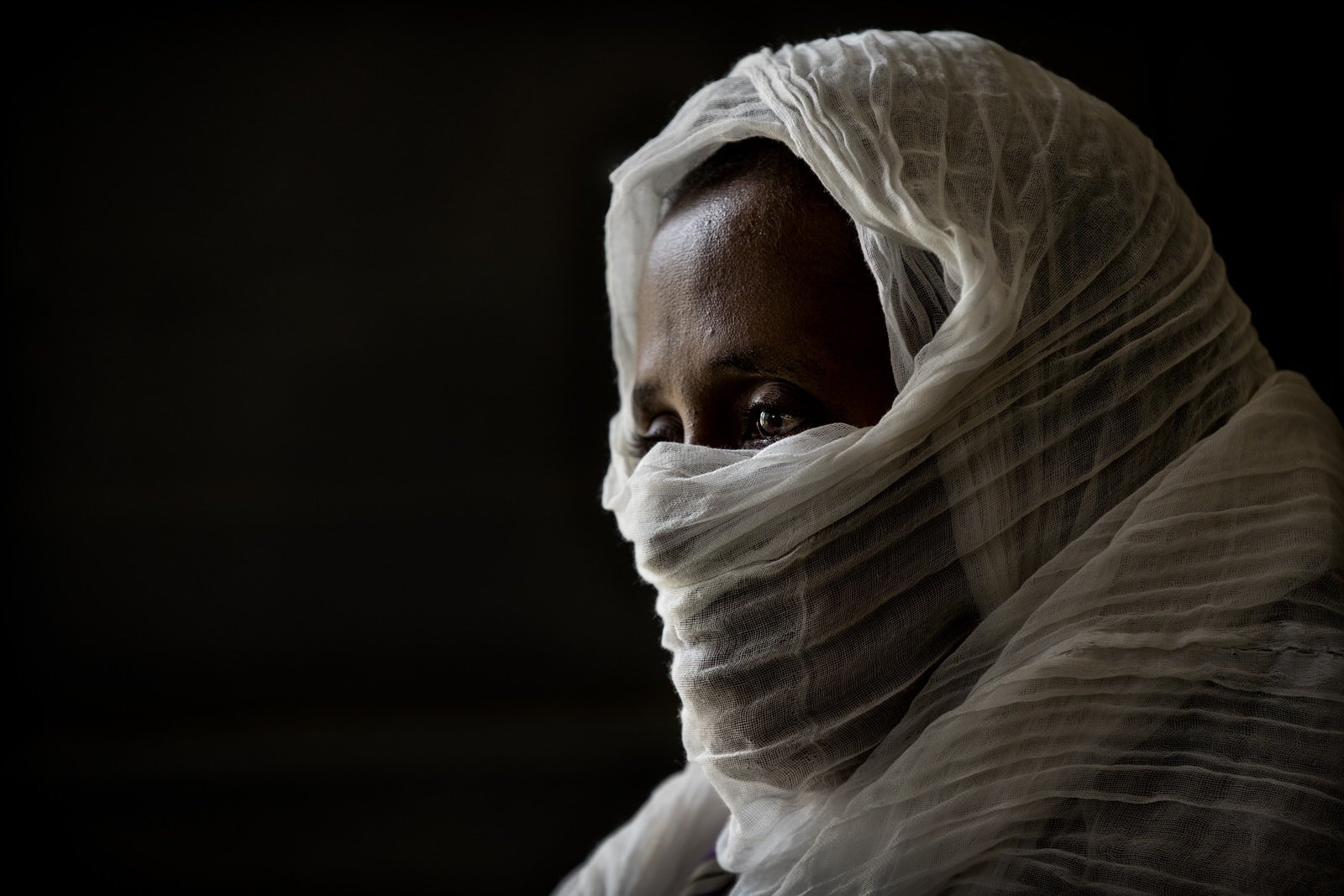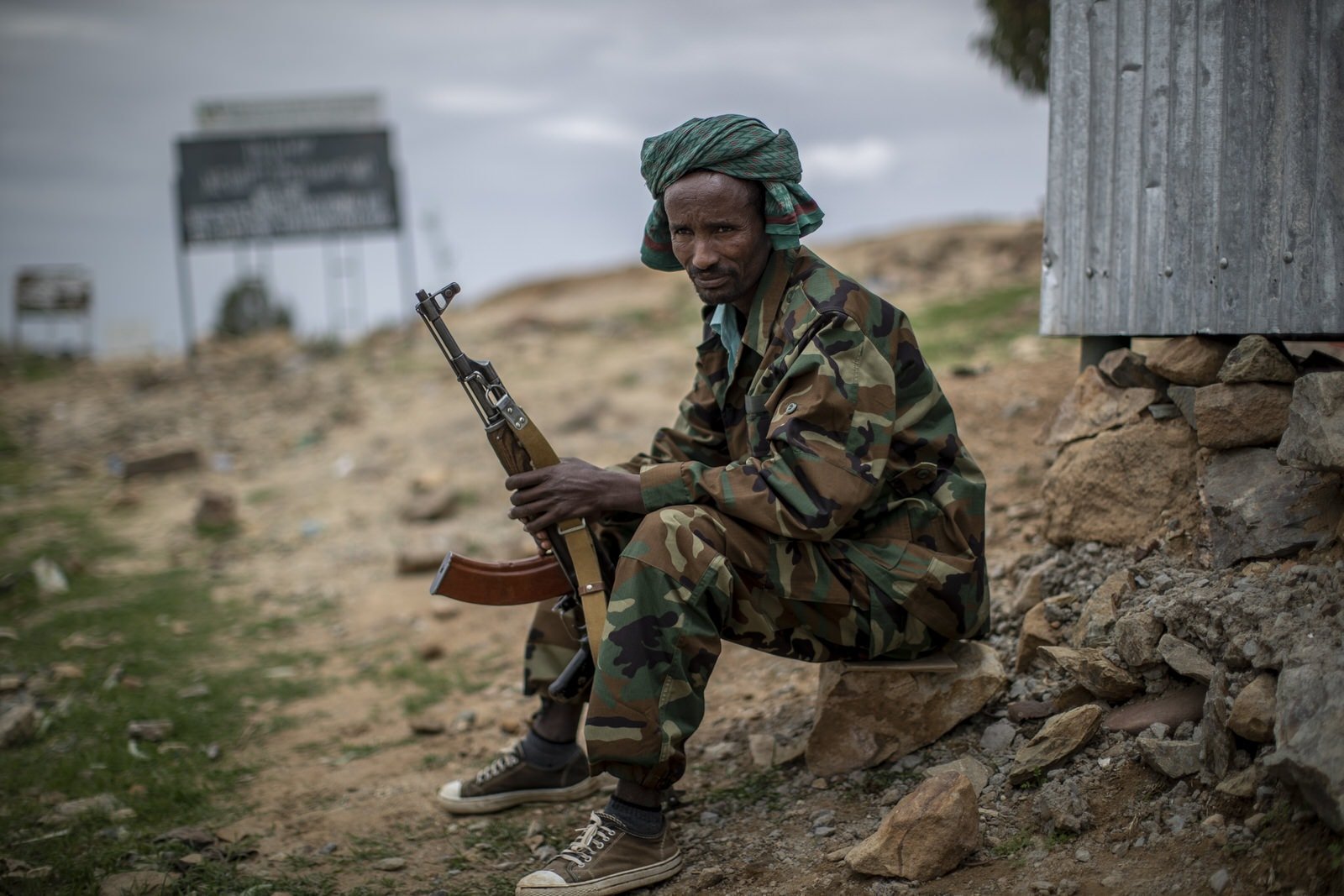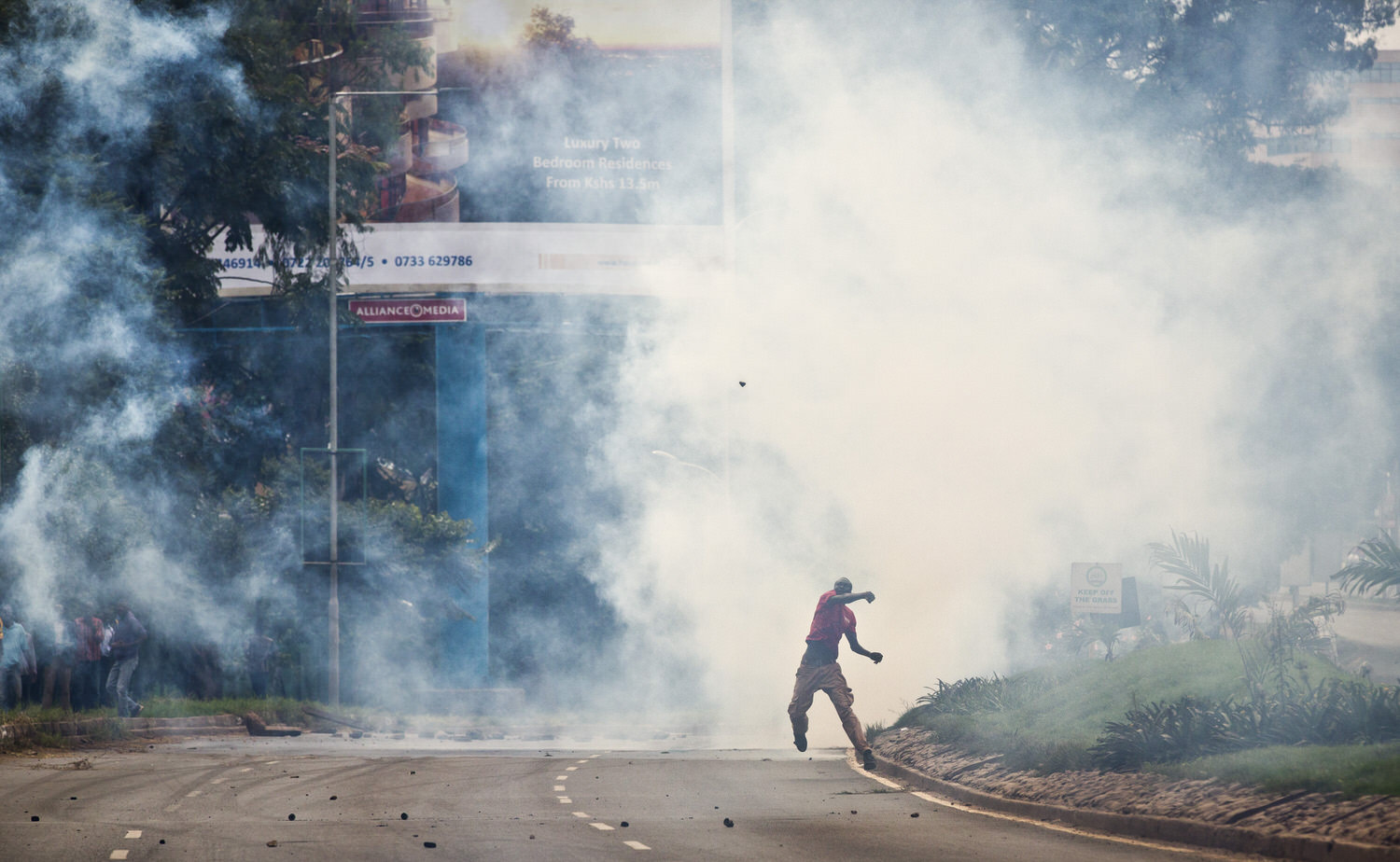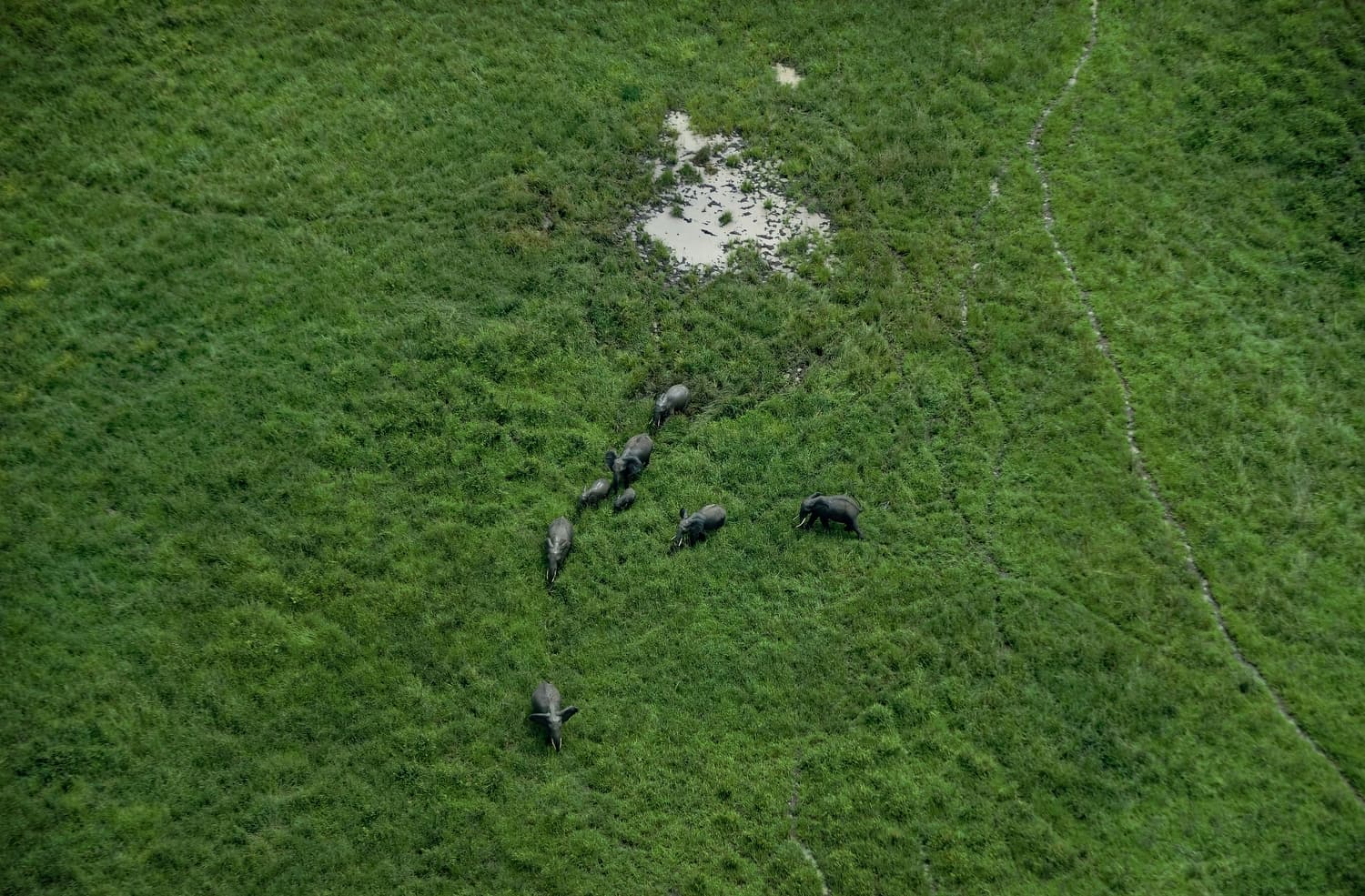Tigray: Hunger crisis
In mid-2021, hundreds of thousands of people faced famine in the Tigray region of Ethiopia, the United Nations said. In areas where the AP obtained access farmers, aid workers and local officials confirmed that food had been turned into a weapon of war.
(Use the white dot at the bottom-right of each image to view captions)
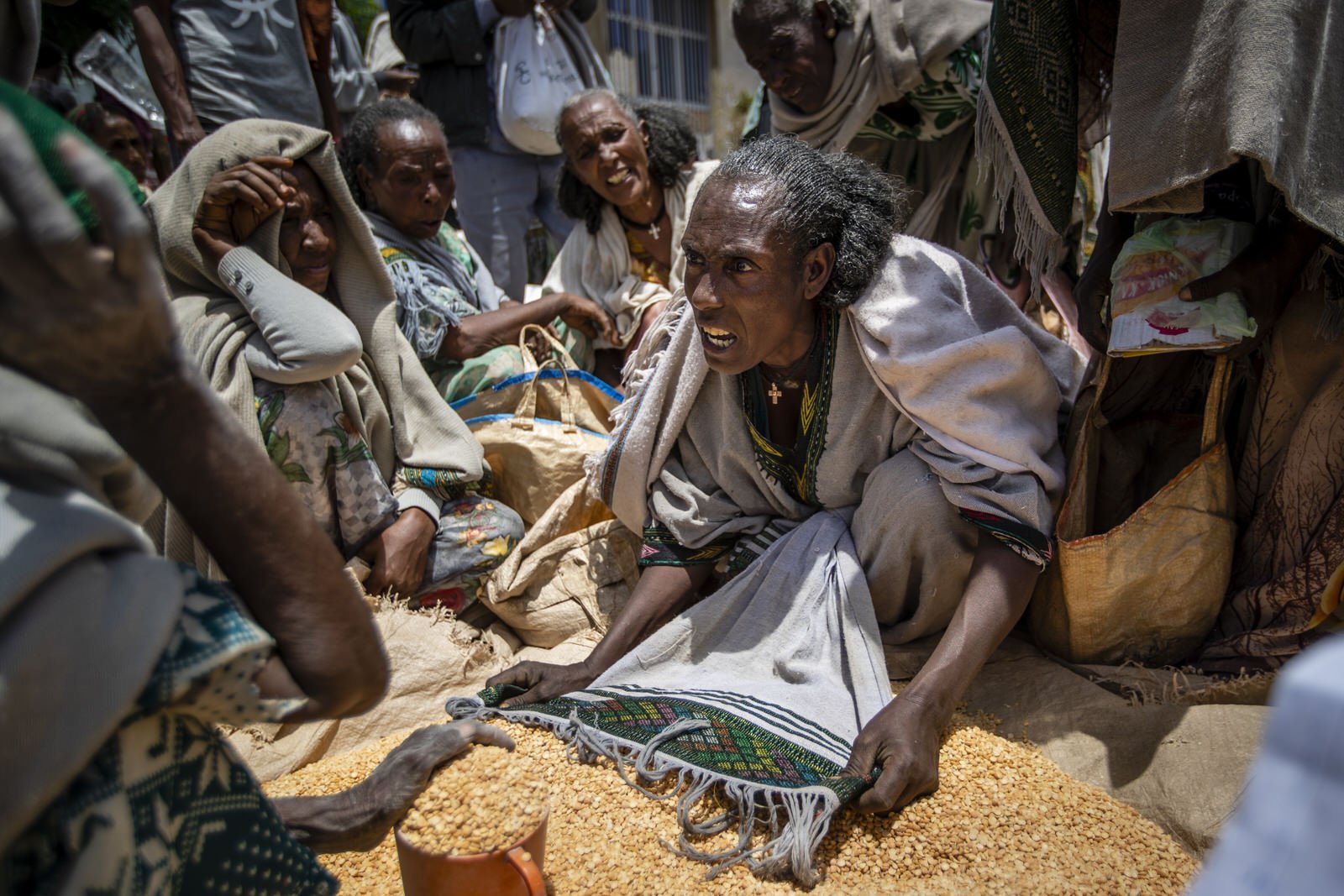
An Ethiopian woman argues with others over the allocation of yellow split peas after it was distributed by the Relief Society of Tigray in the town of Agula, in the Tigray region of northern Ethiopia, on Saturday, May 8, 2021. In war-torn Tigray, more than 350,000 people already face famine, according to the U.N. and other humanitarian groups. It is not just that people are starving; it is that many are being starved, The Associated Press found. (AP Photo/Ben Curtis)
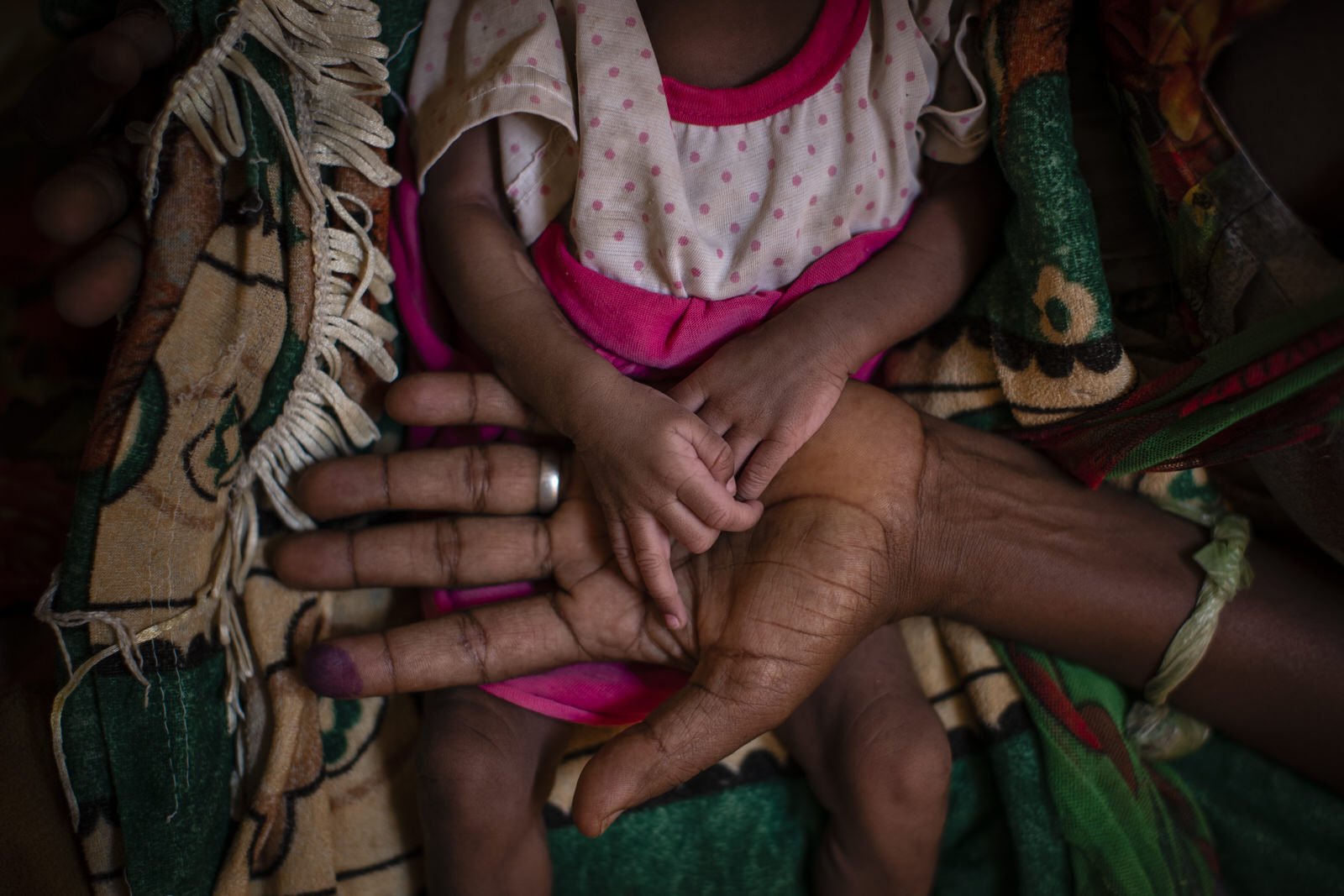
Abeba Gebru, 37, from the village of Getskimilesley, holds the hands of her malnourished daughter, Tigsti Mahderekal, 20 days old, in the treatment tent of a medical clinic in the town of Abi Adi, in the Tigray region of northern Ethiopia, on Tuesday, May 11, 2021. She had the baby at home and walked 12 days to get the famished child to a clinic in the northern Ethiopian region of Tigray. “She survived because I held her close to my womb and kept hiding during the exhausting journey." (AP Photo/Ben Curtis)
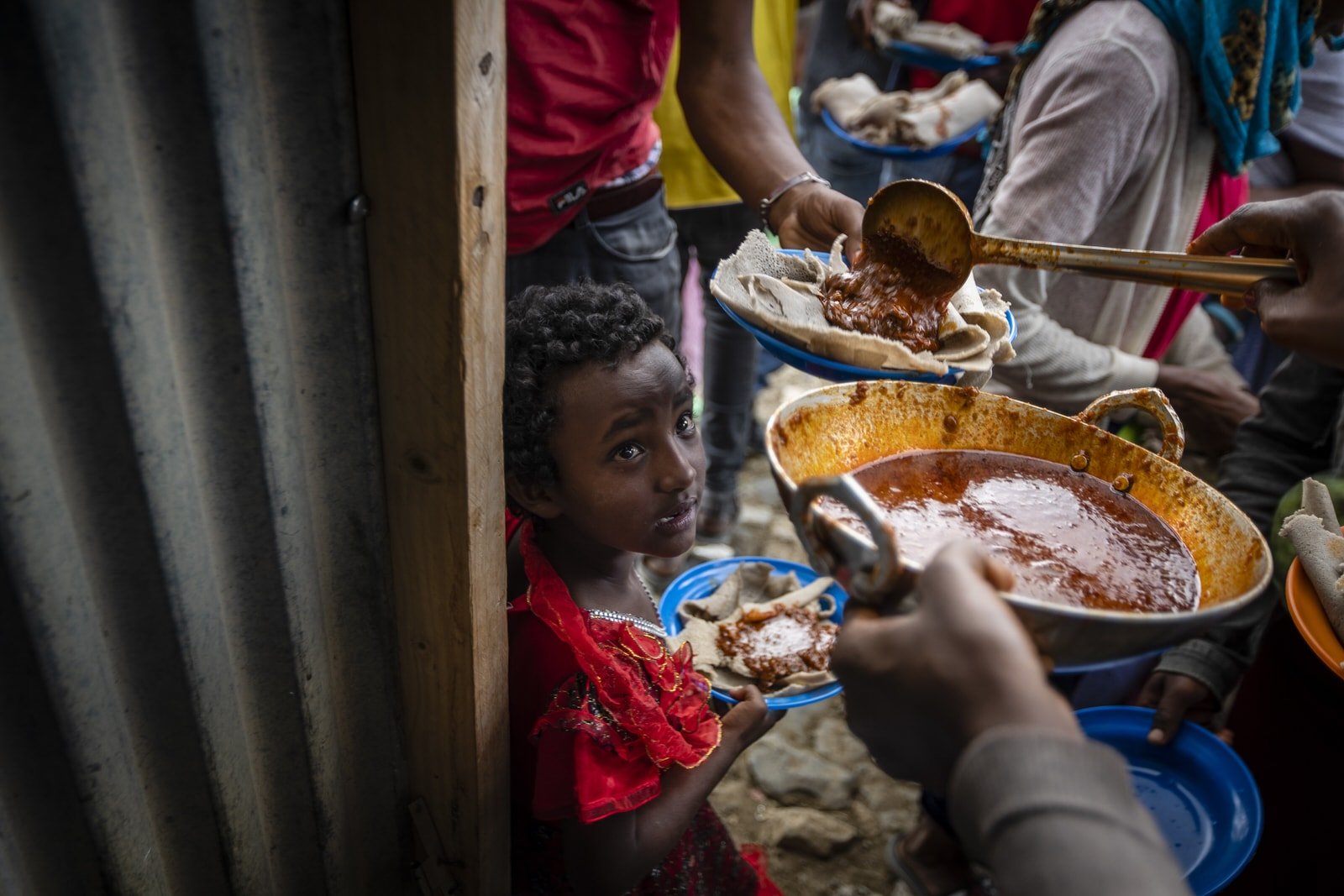
Elena, 7, center, lines up with other displaced Tigrayans to receive food donated by local residents at a reception center for the internally displaced in Mekele, in the Tigray region of northern Ethiopia, on Sunday, May 9, 2021. The 15 kilograms of wheat, half a kilogram of peas and some cooking oil per person, to last a month — was earmarked only for the most vulnerable. That included pregnant mothers and elderly people. (AP Photo/Ben Curtis)
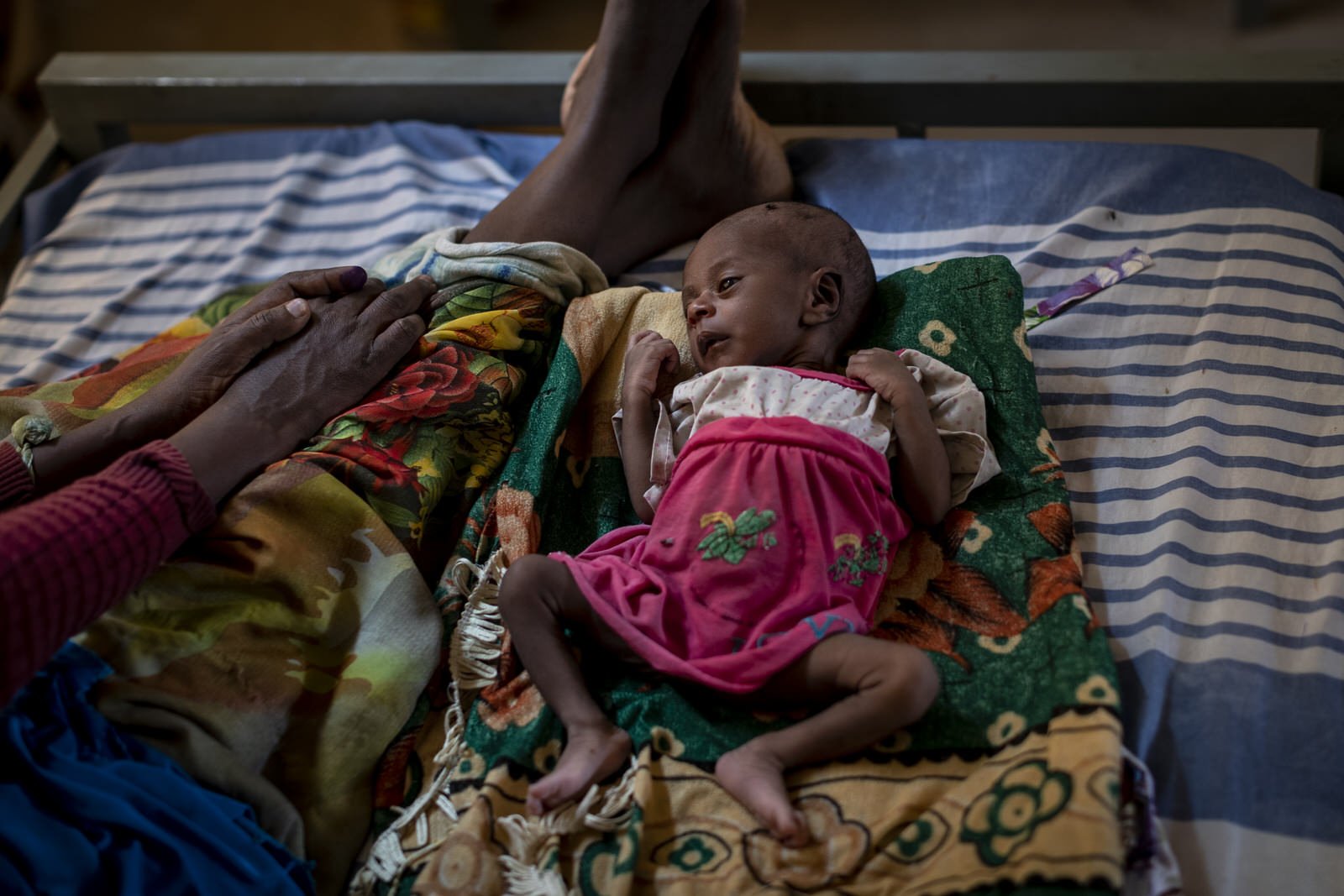
Abeba Gebru, 37, from the village of Getskimilesley, sits with her malnourished daughter, Tigsti Mahderekal, 20 days old, in the treatment tent of a medical clinic in the town of Abi Adi, in the Tigray region of northern Ethiopia, on Tuesday, May 11, 2021. For every mother like Abeba who makes it out, hundreds, possibly thousands, are trapped behind the front lines or military roadblocks in rural areas. (AP Photo/Ben Curtis)
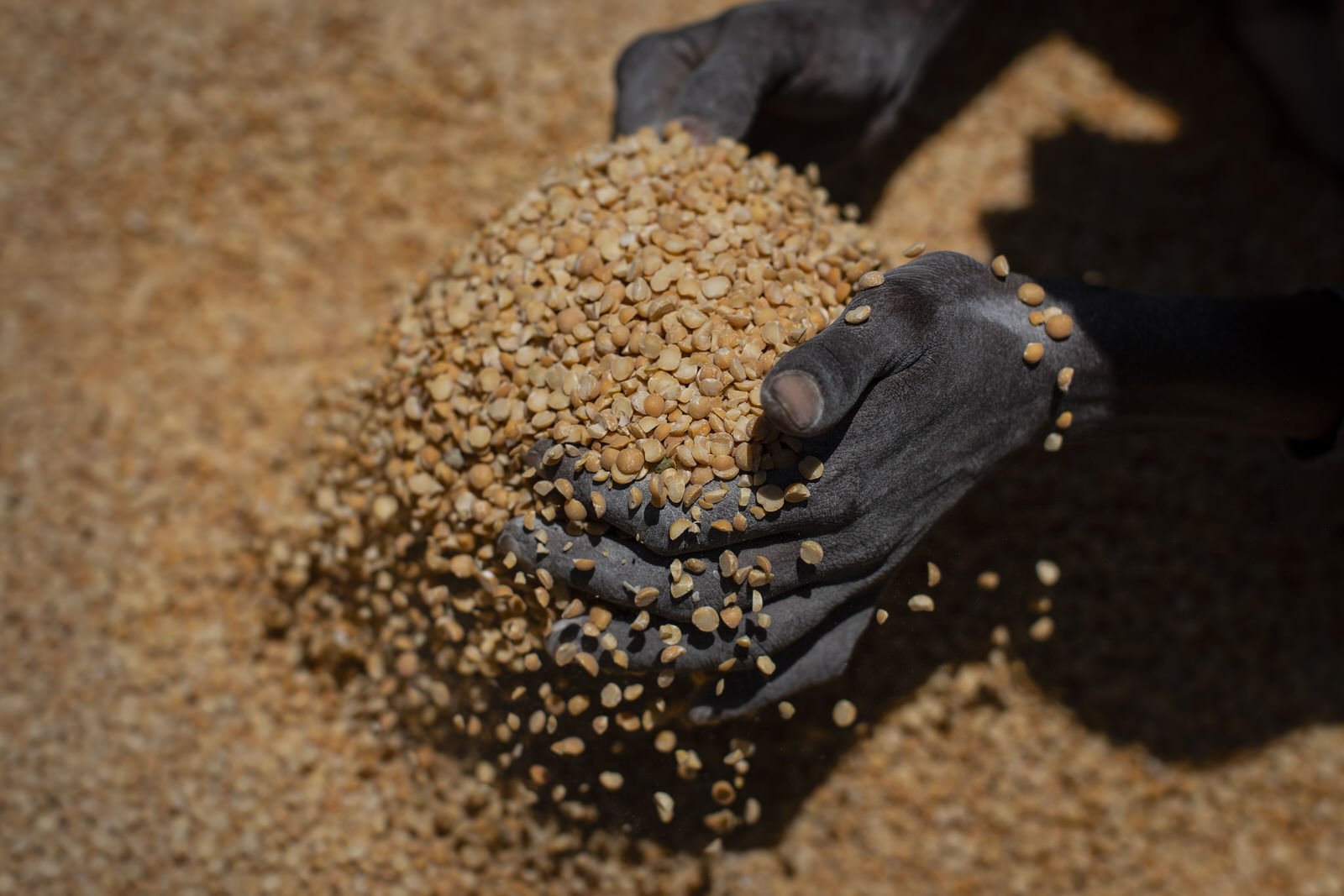
An Ethiopian woman scoops up portions of yellow split peas to be allocated to waiting families after it was distributed by the Relief Society of Tigray in the town of Agula, in the Tigray region of northern Ethiopia, on Saturday, May 8, 2021. The war in Tigray has spawned massacres, gang rapes and the widespread expulsion of people from their homes, and the United States has declared “ethnic cleansing” in western Tigray. Now, on top of those atrocities, Tigrayans face another urgent problem: hunger and starvation. (AP Photo/Ben Curtis)
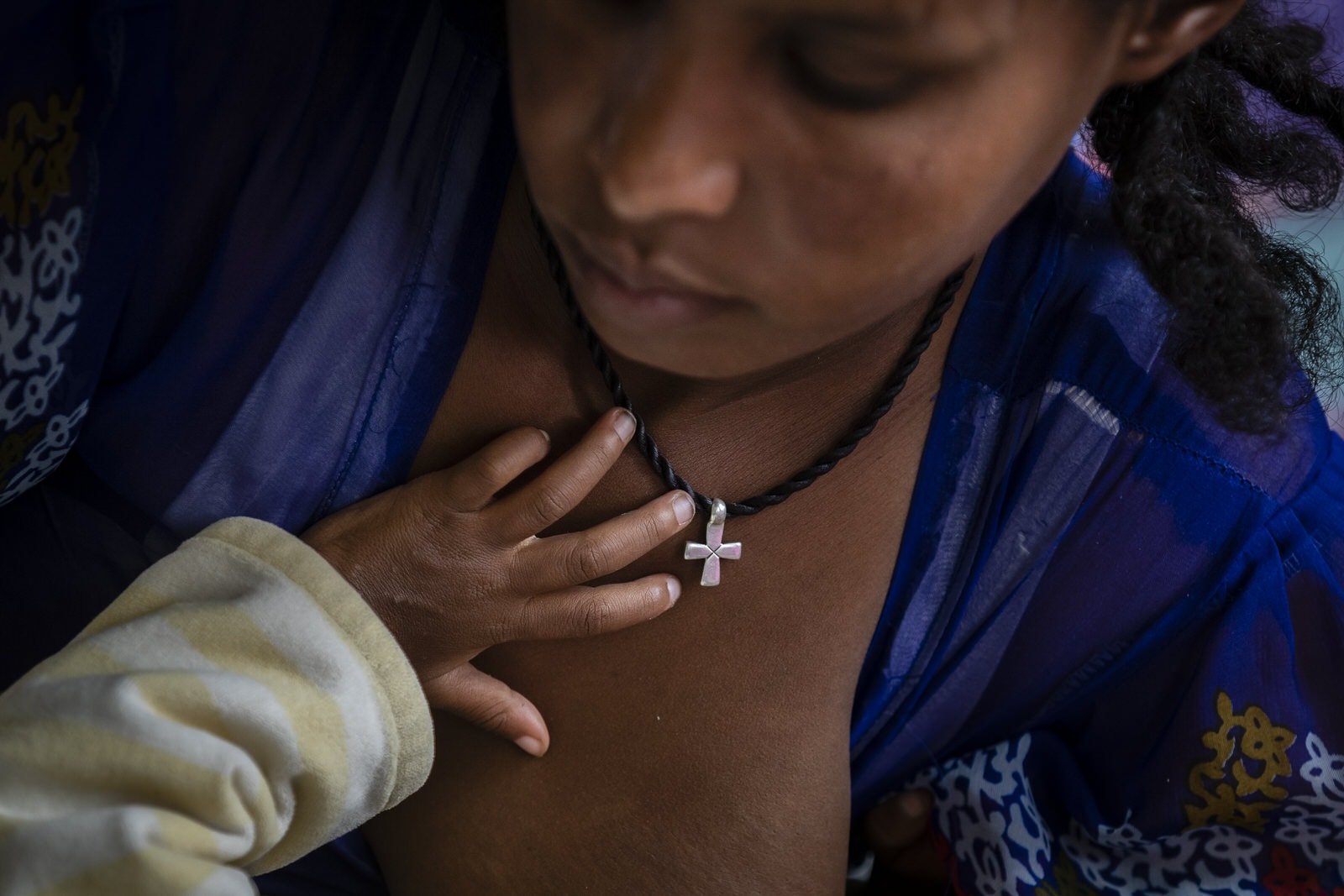
Tekien Tadese, 25, wearing an Ethiopian Orthodox Christian cross, holds her baby, Amanuel Mulu, 22 months old, who is suffering from malnutrition and weighs only 6.7 kilograms (14 pounds and 12 ounces), at the Ayder Referral Hospital in Mekele, in the Tigray region of northern Ethiopia, on Monday, May 10, 2021. The child was unconscious when he was first admitted in April, severely malnourished and anemic after losing half his body weight. Two weeks in intensive care saved his life. (AP Photo/Ben Curtis)
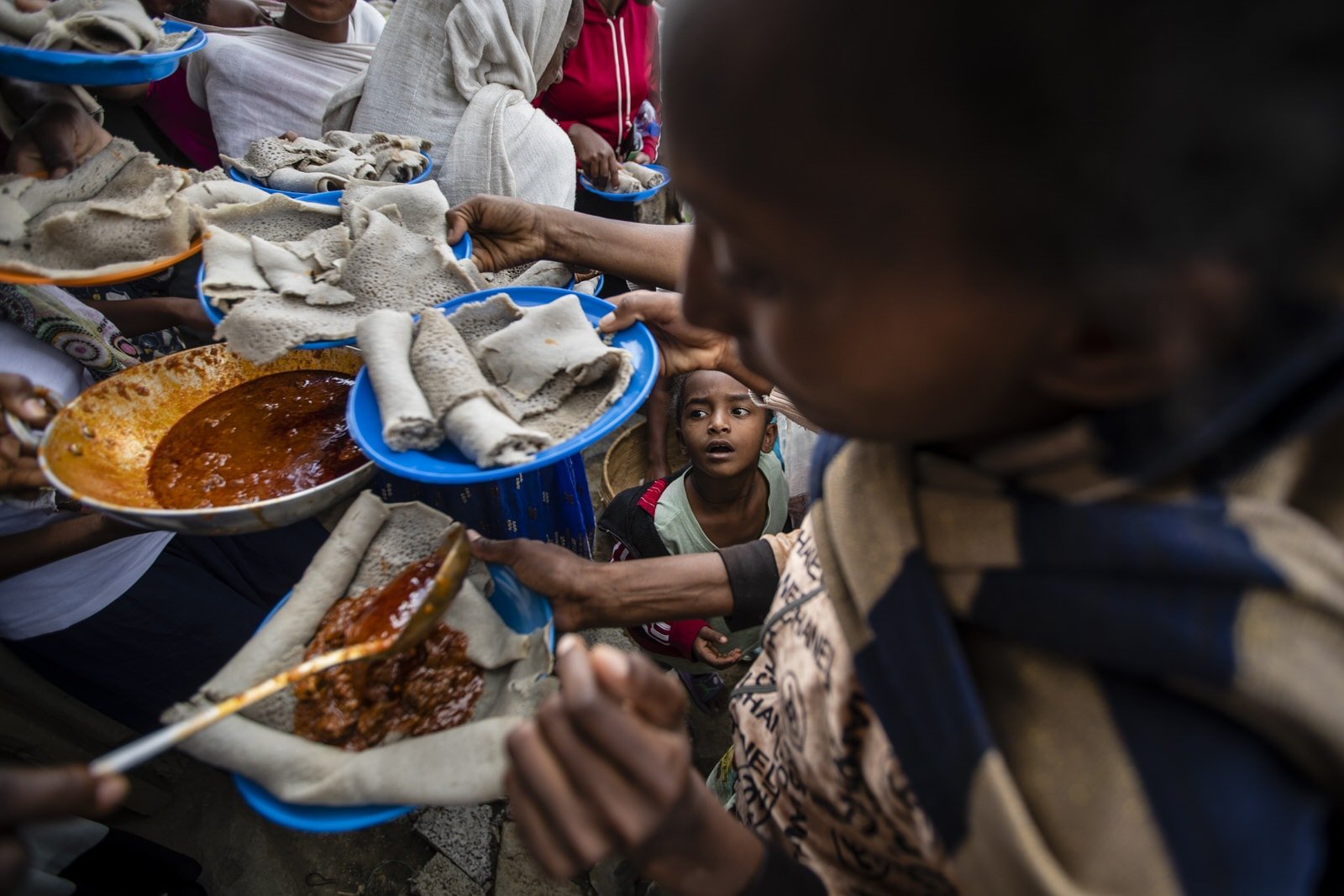
A young boy looks up as displaced Tigrayans line up to receive food donated by local residents at a reception center for the internally displaced in Mekele, in the Tigray region of northern Ethiopia, on Sunday, May 9, 2021. The 15 kilograms of wheat, half a kilogram of peas and some cooking oil per person, to last a month — was earmarked only for the most vulnerable. That included pregnant mothers and elderly people. (AP Photo/Ben Curtis)
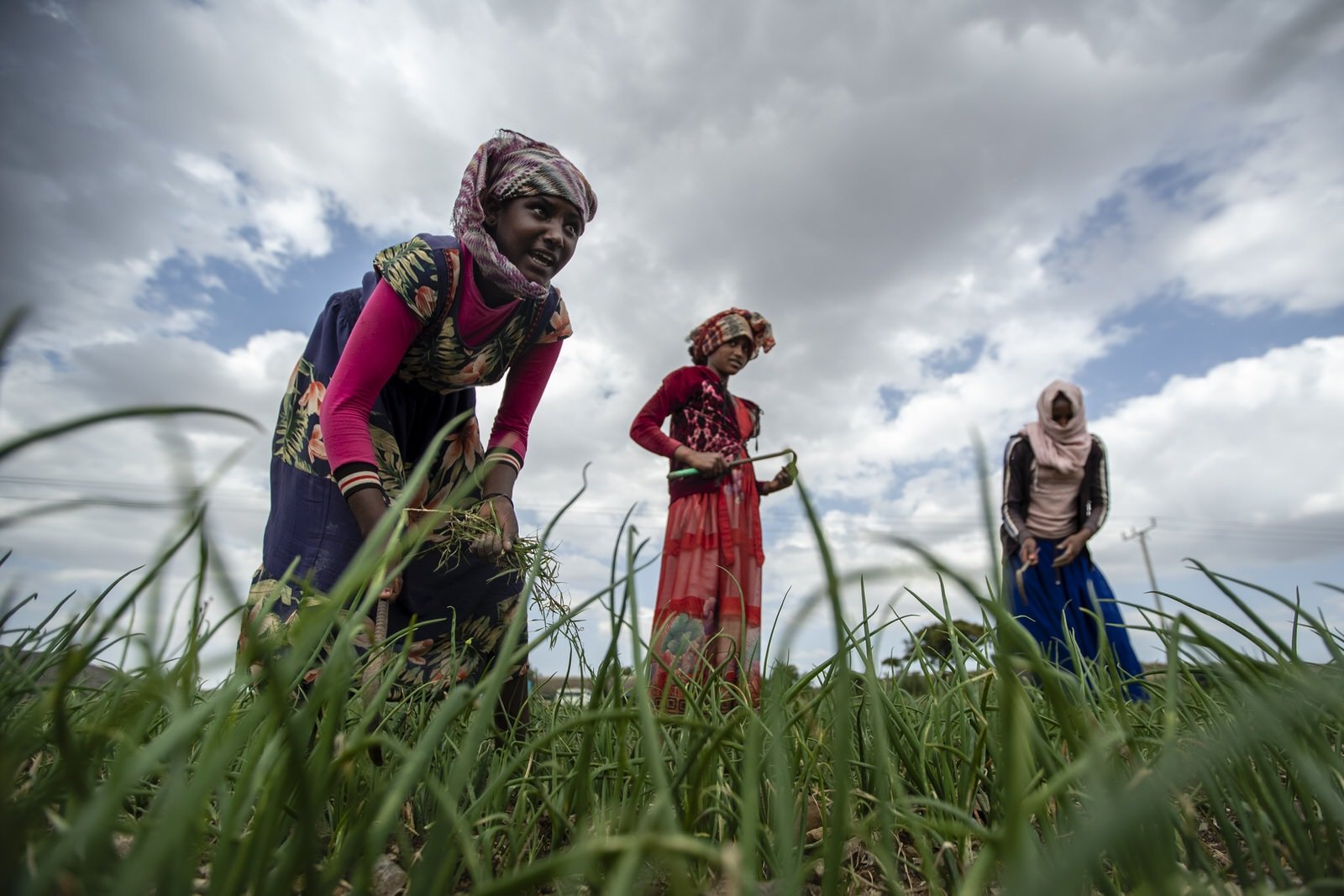
Ethiopian women work to turn over the soil and remove weeds from a field of onions near the village of Merebmieti, an area relatively unaffected by the current conflict, south of Mekele, in the Tigray region of northern Ethiopia, on Wednesday, May 12, 2021. The war in Tigray started in early November, shortly before the harvest season, as an attempt by Ethiopian Prime Minister Abiy Ahmed to disarm the region’s rebellious leaders. (AP Photo/Ben Curtis)

An Ethiopian man carries a sack of wheat on his shoulders to be distributed by the Relief Society of Tigray in the town of Agula, in the Tigray region of northern Ethiopia, on Saturday, May 8, 2021. In war-torn Tigray, more than 350,000 people already face famine, according to the U.N. and other humanitarian groups. It is not just that people are starving; it is that many are being starved, The Associated Press found. (AP Photo/Ben Curtis)
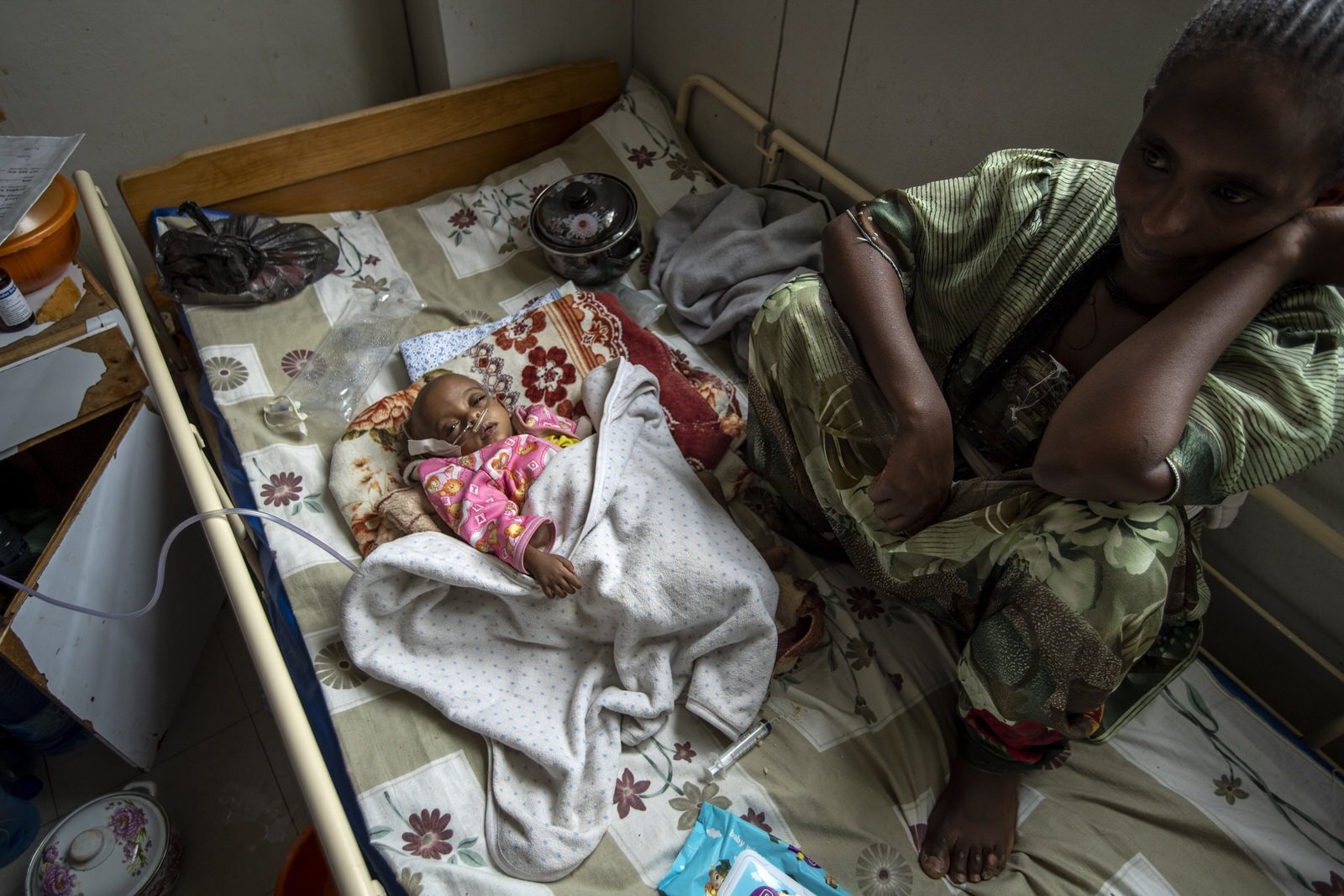
Birhan Etsana, 27, from Dengelat, sits with her malnourished baby, Mebrhit, who at 17 months old weighs just 5.2 kilograms (11 pounds and 7 ounces), at the Ayder Referral Hospital in Mekele, in the Tigray region of northern Ethiopia, on Monday, May 10, 2021. The lone survivor of her triplets, the infant was admitted with complications stemming from severe acute malnutrition, including heart failure. (AP Photo/Ben Curtis)
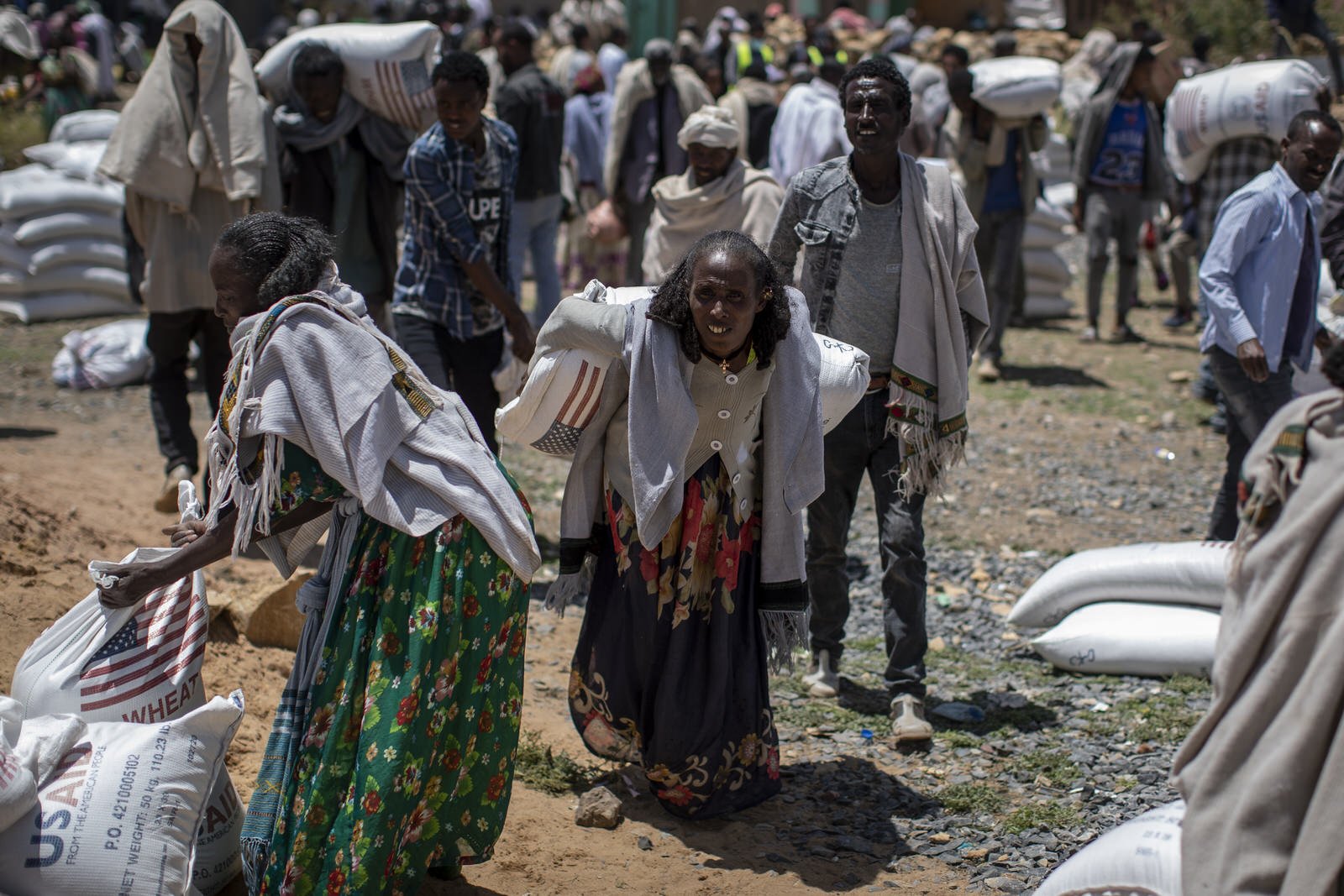
Ethiopian women carry away sacks of wheat after a food distribution by the Relief Society of Tigray in the town of Agula, in the Tigray region of northern Ethiopia, on Saturday, May 8, 2021. (AP Photo/Ben Curtis)
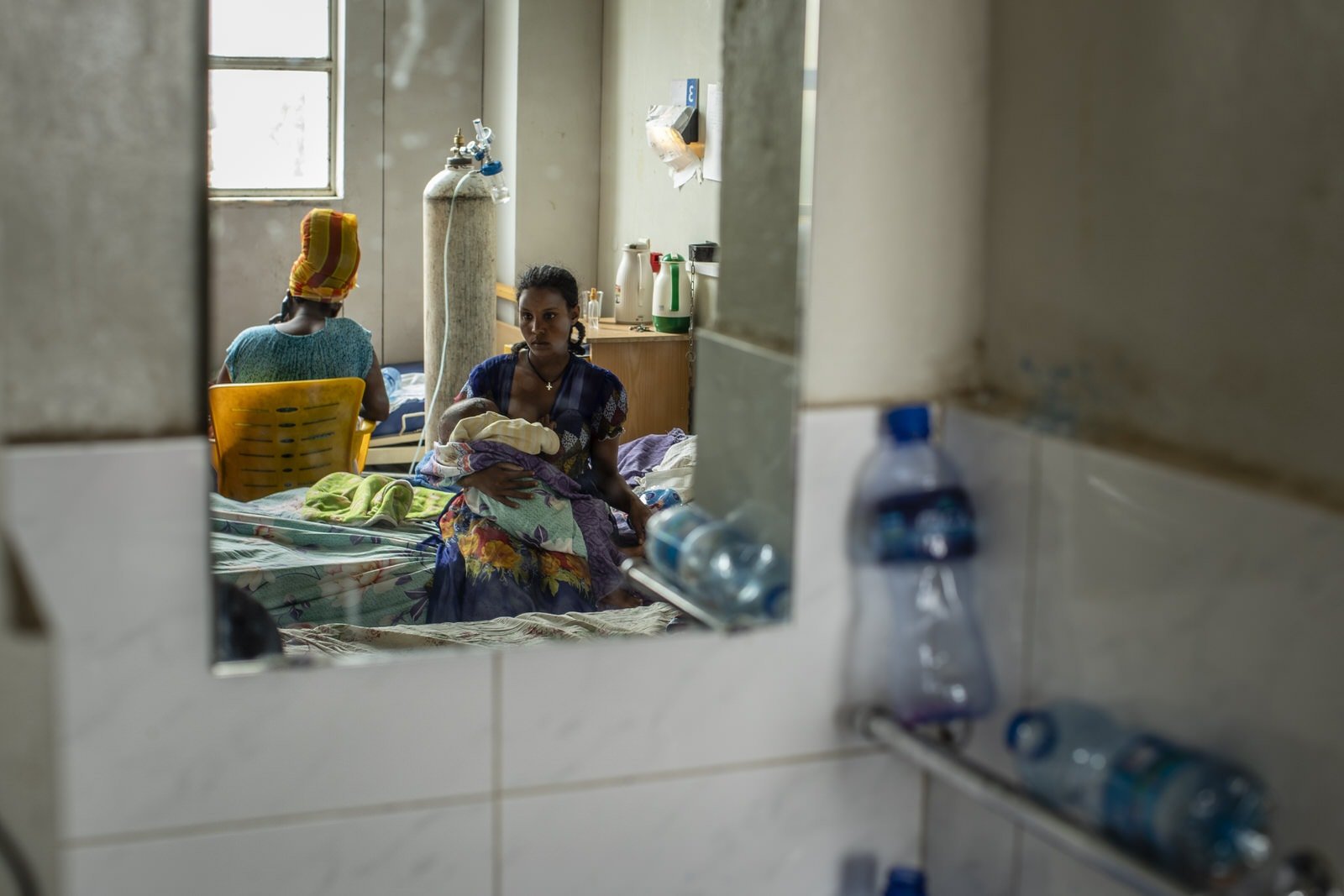
Tekien Tadese, 25, holds her baby, Amanuel Mulu, 22 months old, who is suffering from malnutrition and weighs only 6.7 kilograms (14 pounds and 12 ounces), at the Ayder Referral Hospital in Mekele, in the Tigray region of northern Ethiopia, on Monday, May 10, 2021. The child was unconscious when he was first admitted in April, severely malnourished and anemic after losing half his body weight. Two weeks in intensive care saved his life. (AP Photo/Ben Curtis)
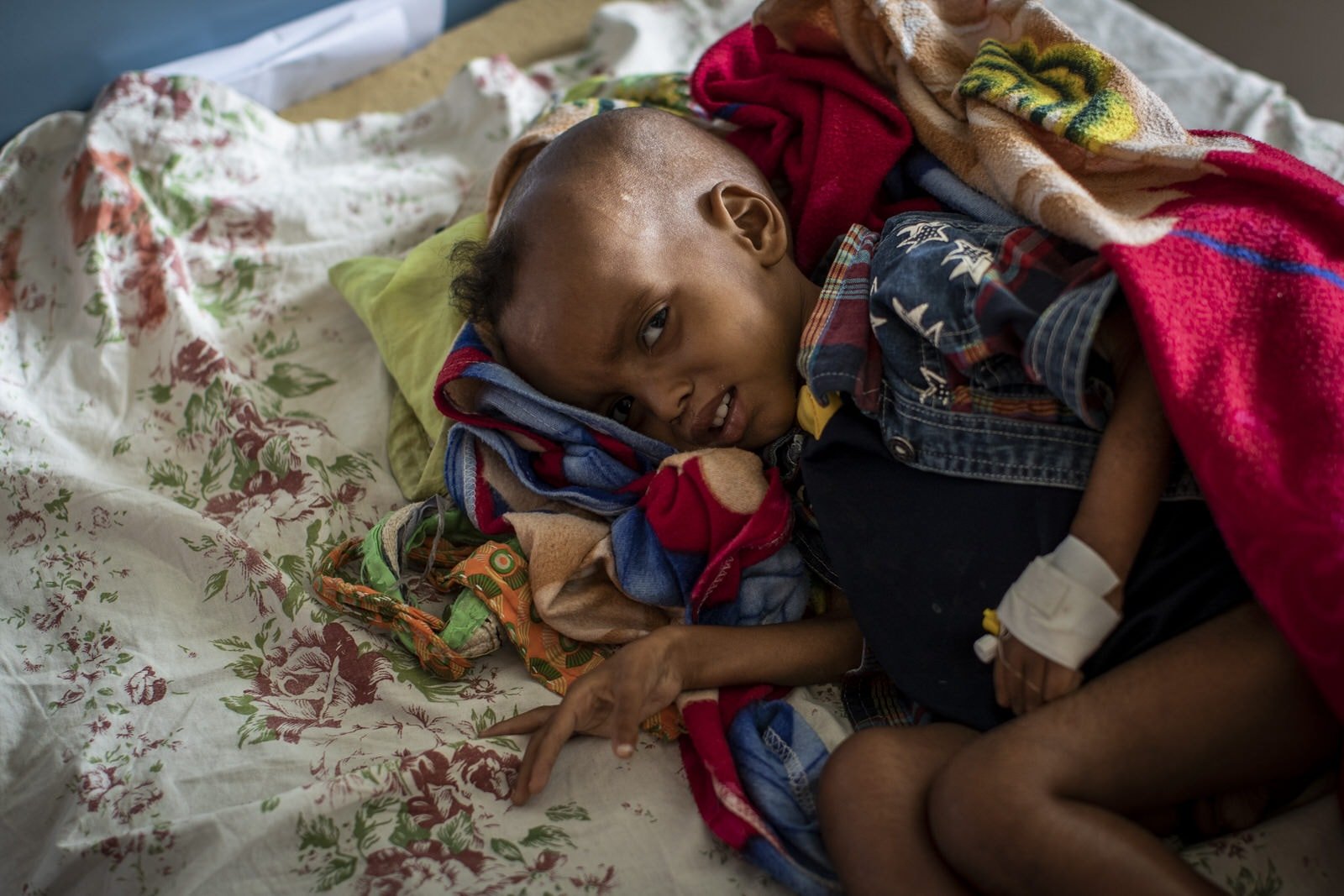
Gebre Kidan Gebrehiwet, 2, is treated for malnutrition after fleeing from the town of Abi Adi with his mother, Abeba Tesfay, at the Ayder Referral Hospital in Mekele, in the Tigray region of northern Ethiopia, on Thursday, May 6, 2021. Birhanu Gebremedhin, health coordinator for the district of Abi Adi, says, “This malnutrition is caused by the conflict. … They’ve stolen their food, their equipment, and some were killed by the troops even. So they are not able to feed their children.” (AP Photo/Ben Curtis)
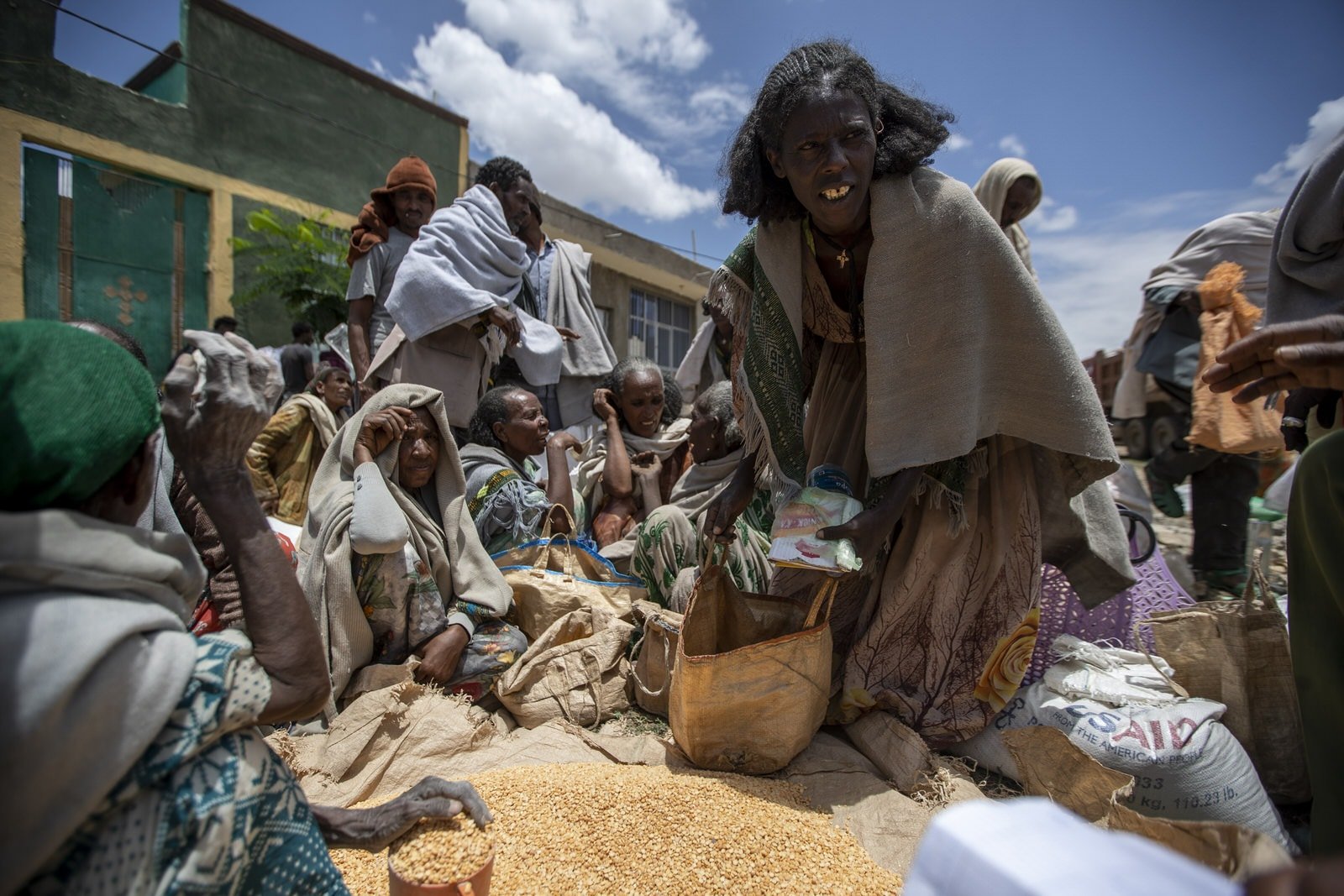
An Ethiopian woman leaves with a portion of yellow split peas after it was distributed by the Relief Society of Tigray in the town of Agula, in the Tigray region of northern Ethiopia, on Saturday, May 8, 2021. The 15 kilograms of wheat, half a kilogram of peas and some cooking oil per person, to last a month — was earmarked only for the most vulnerable. That included pregnant mothers and elderly people. (AP Photo/Ben Curtis)
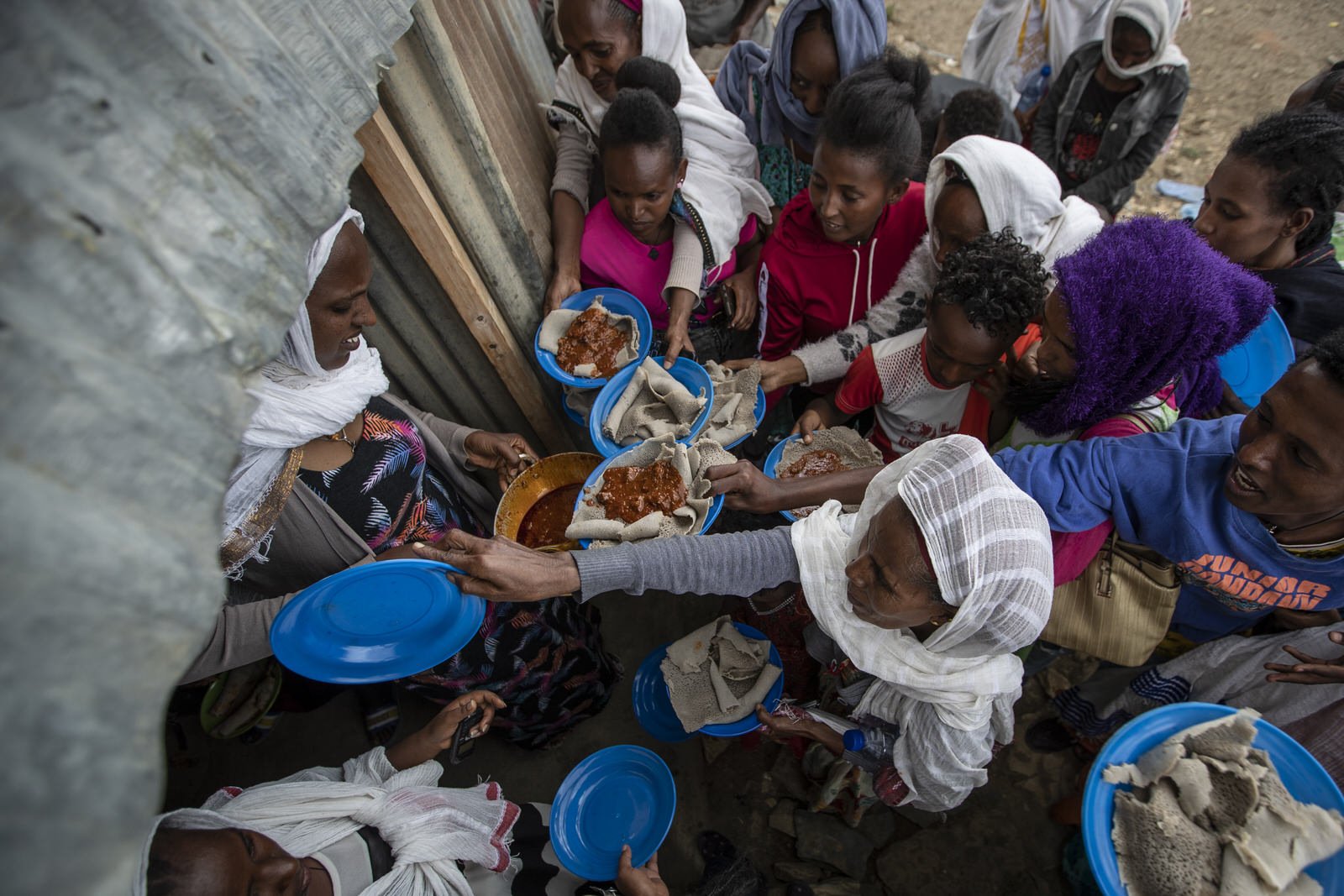
Displaced Tigrayans line up to receive food donated by local residents at a reception center for the internally displaced in Mekele, in the Tigray region of northern Ethiopia, on Sunday, May 9, 2021. In war-torn Tigray, more than 350,000 people already face famine, according to the U.N. and other humanitarian groups. It is not just that people are starving; it is that many are being starved, The Associated Press found. (AP Photo/Ben Curtis)
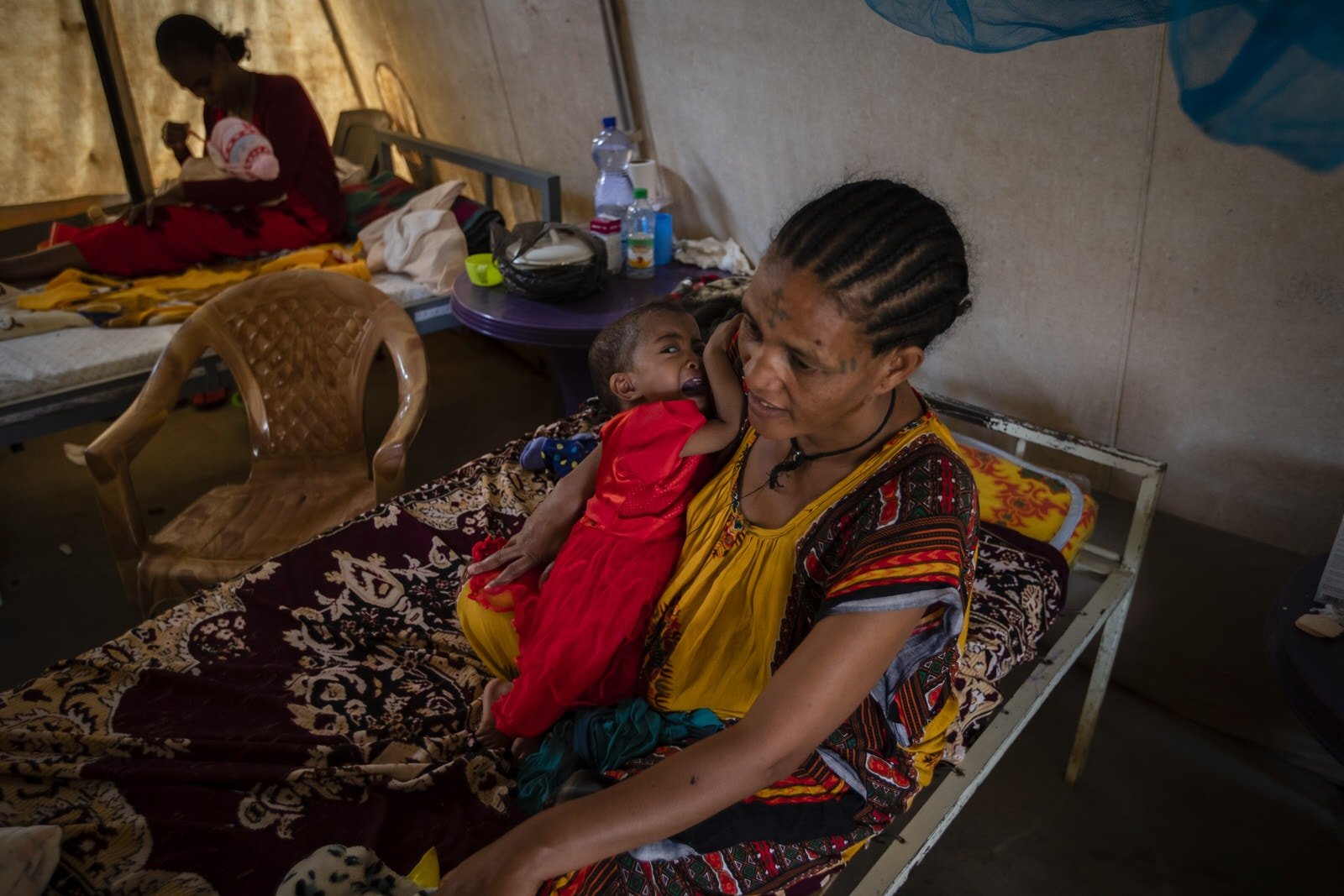
Mother Roman Kidanemariam, 35, holds her malnourished daughter, Merkab Ataklti, 22 months old, in the treatment tent of a medical clinic in the town of Abi Adi, in the Tigray region of northern Ethiopia, on Tuesday, May 11, 2021. Birhanu Gebremedhin, health coordinator for the district of Abi Adi, says, “This malnutrition is caused by the conflict. … They’ve stolen their food, their equipment, and some were killed by the troops even. So they are not able to feed their children.” (AP Photo/Ben Curtis)
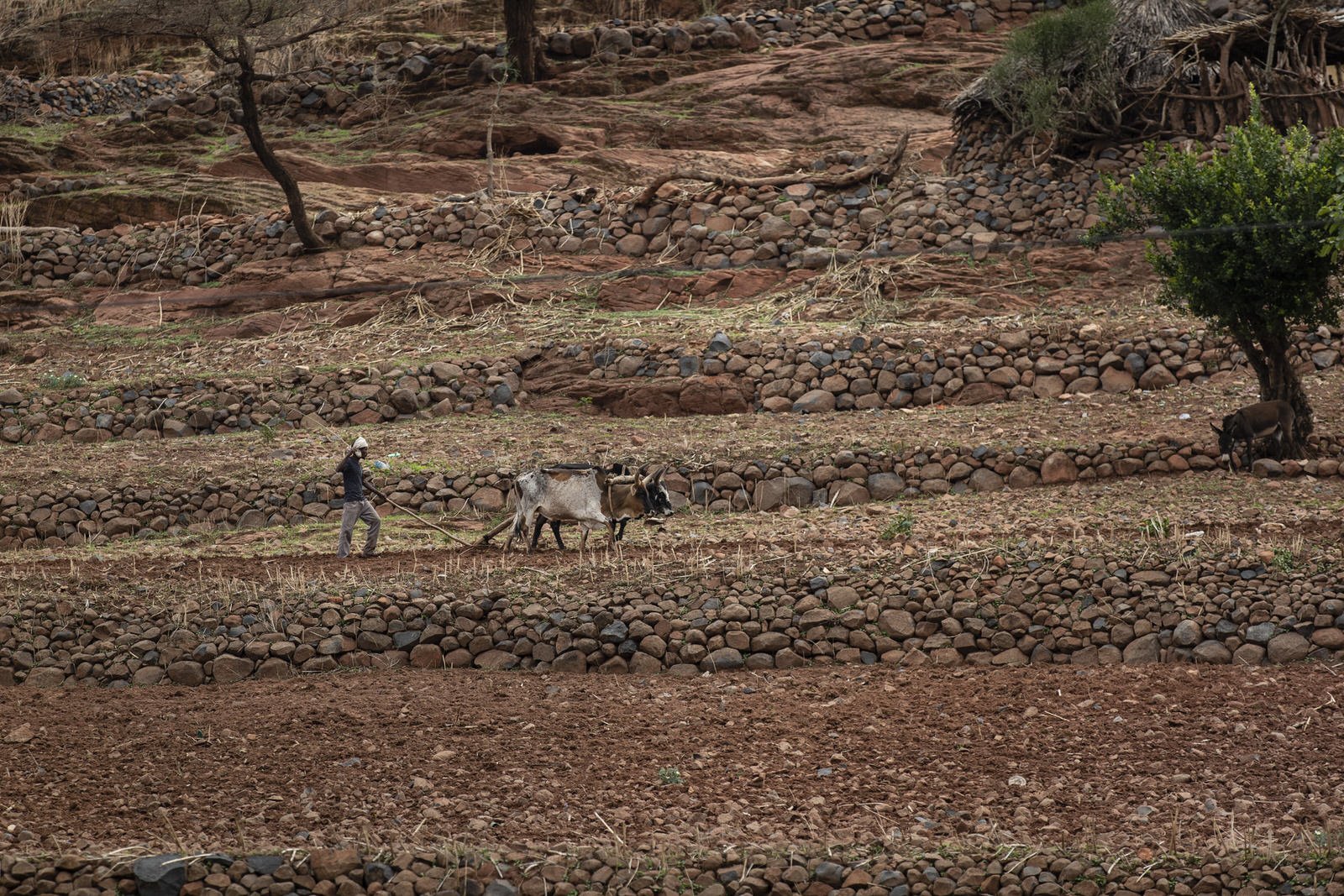
A farmer uses oxen to plough terraced land by the side of a road leading to the town of Abi Adi, in the Tigray region of northern Ethiopia, on Tuesday, May 11, 2021. The war in Tigray started in early November, shortly before the harvest season, as an attempt by Ethiopian Prime Minister Abiy Ahmed to disarm the region’s rebellious leaders. (AP Photo/Ben Curtis)
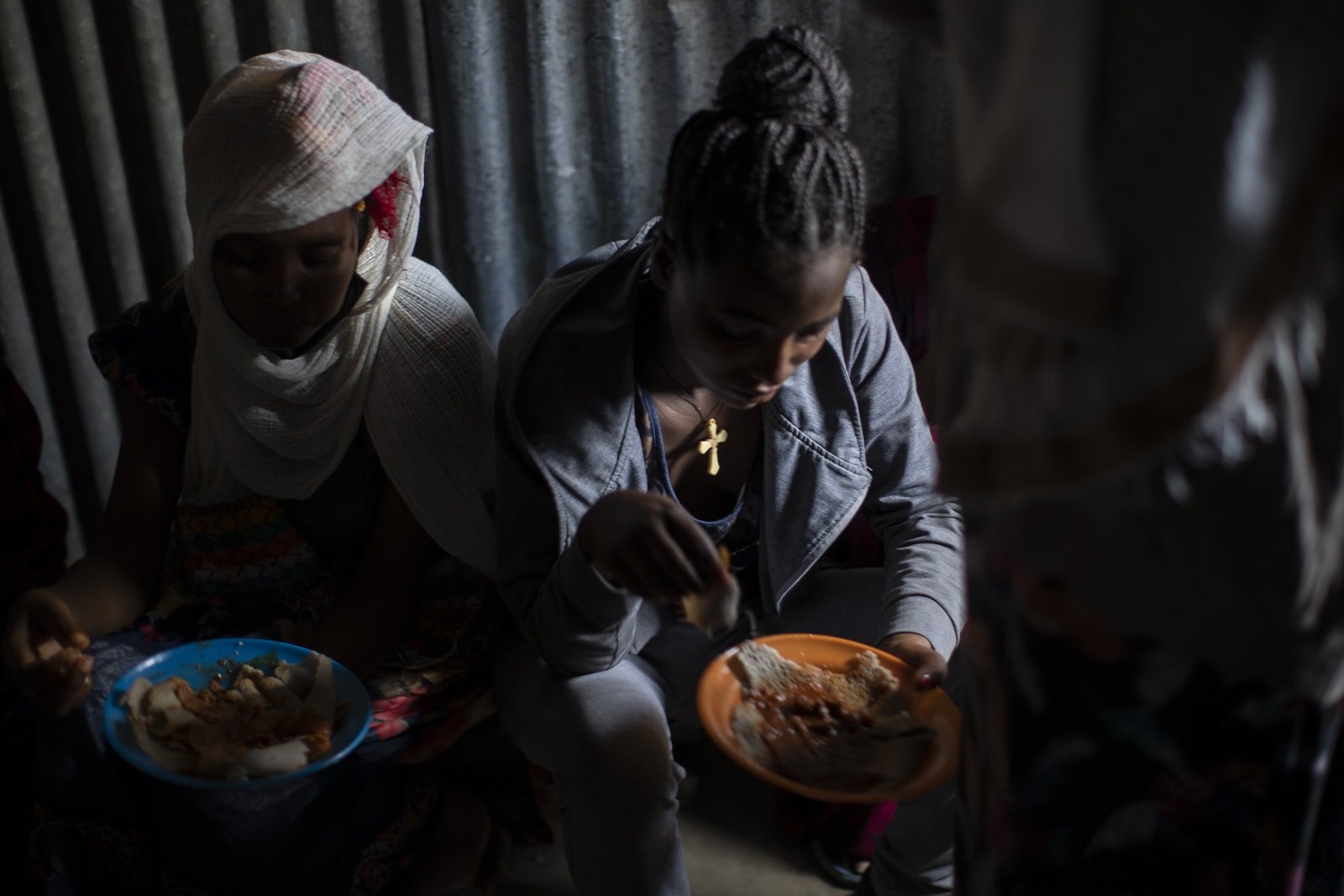
Displaced Tigrayan women, one wearing an Ethiopian Orthodox Christian cross, sit in a metal shack to eat food donated by local residents at a reception center for the internally displaced in Mekele, in the Tigray region of northern Ethiopia, on Sunday, May 9, 2021. (AP Photo/Ben Curtis)
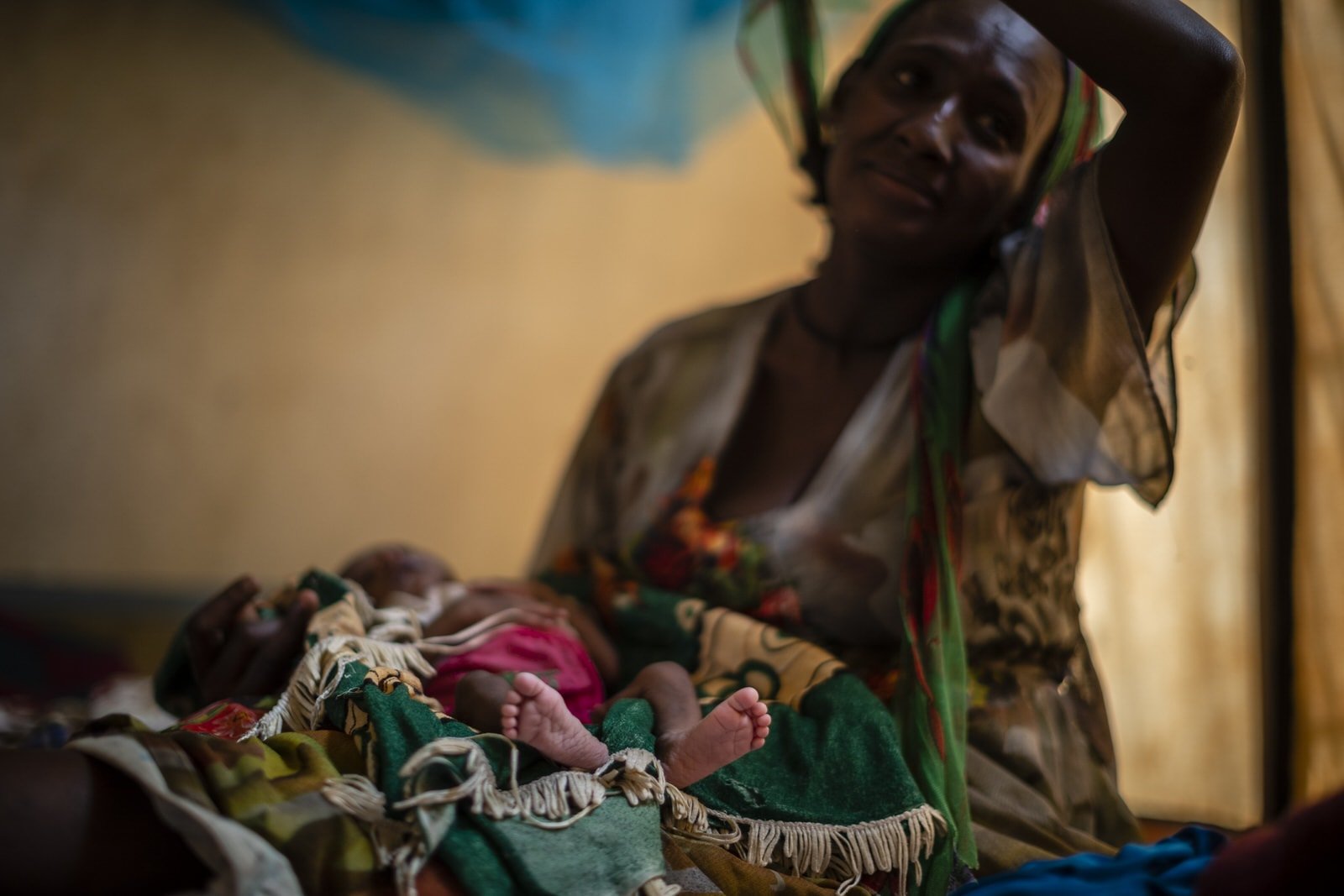
Abeba Gebru, 37, from the village of Getskimilesley, sits with her malnourished daughter, Tigsti Mahderekal, 20 days old, in the treatment tent of a medical clinic in the town of Abi Adi, in the Tigray region of northern Ethiopia, on Tuesday, May 11, 2021. She had the baby at home and walked 12 days to get the famished child to a clinic in the northern Ethiopian region of Tigray. “She survived because I held her close to my womb and kept hiding during the exhausting journey." (AP Photo/Ben Curtis)
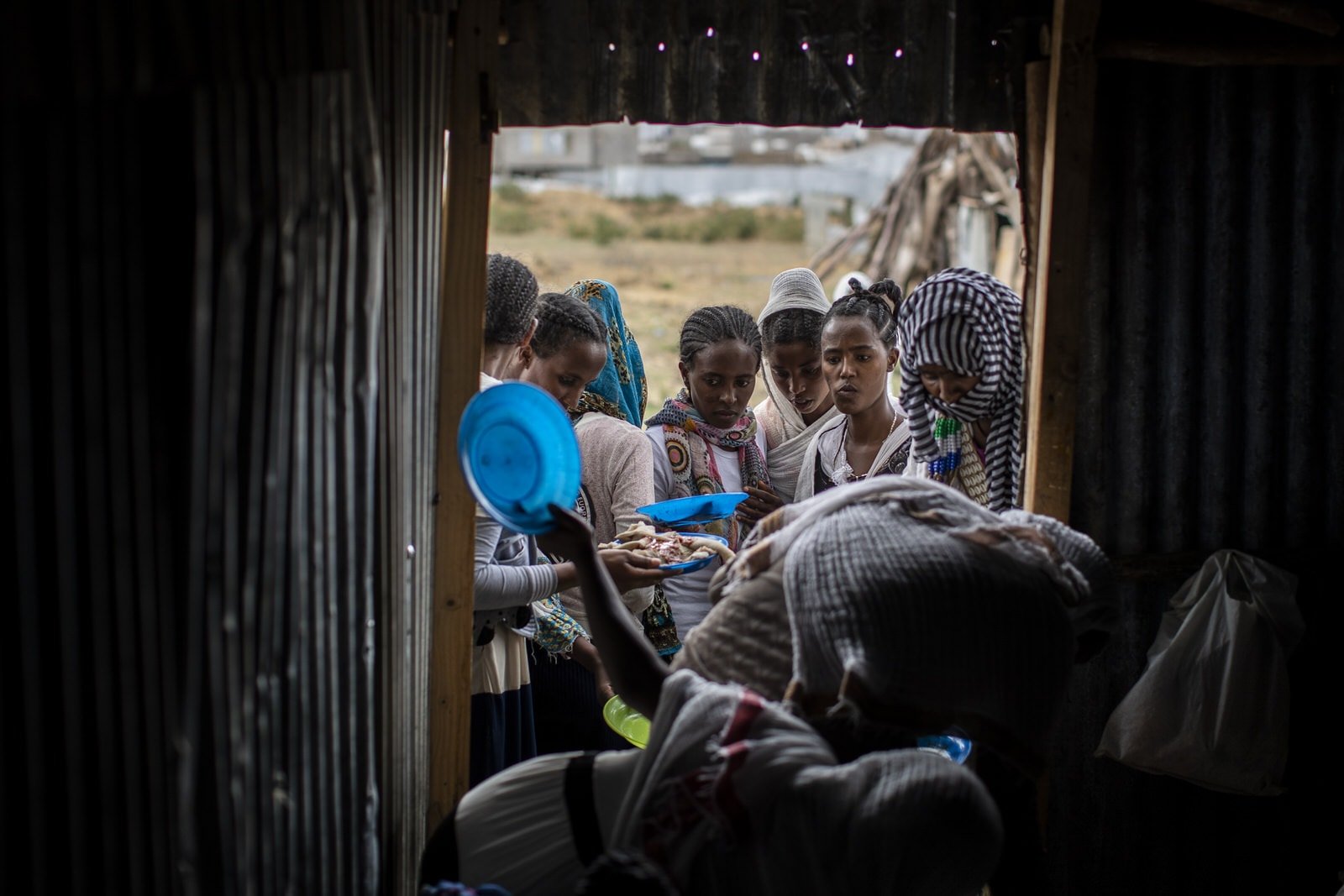
Tigrayans stand in line to receive food donated by local residents at a reception center for the internally displaced in Mekele, in the Tigray region of northern Ethiopia, on Sunday, May 9, 2021. (AP Photo/Ben Curtis)
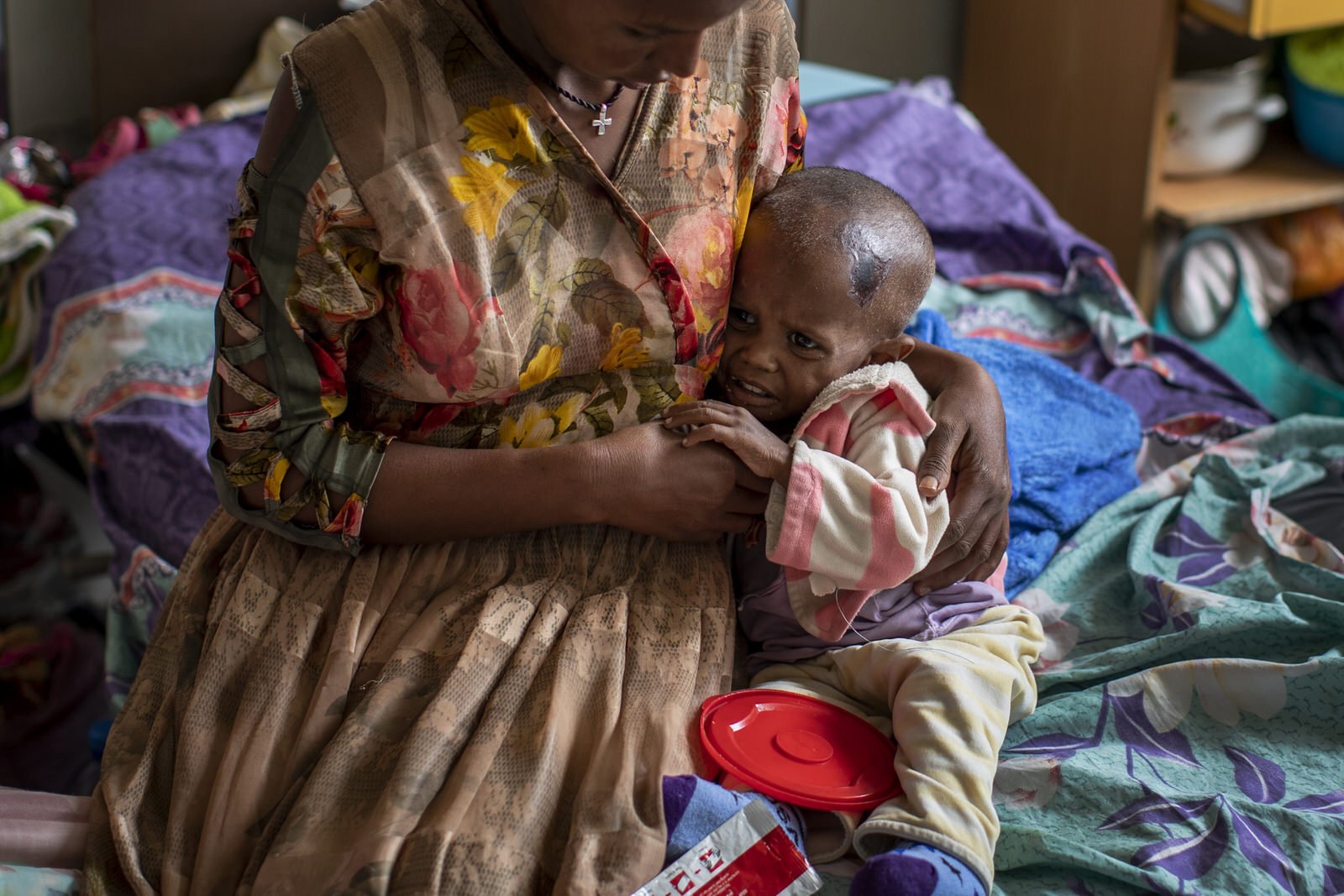
Tekien Tadese, 25, holds her baby, Amanuel Mulu, 22 months old, who is suffering from malnutrition and weighs only 6.7 kilograms (14 pounds and 12 ounces), at the Ayder Referral Hospital in Mekele, in the Tigray region of northern Ethiopia, on Monday, May 10, 2021. The child was unconscious when he was first admitted in April, severely malnourished and anemic after losing half his body weight. Two weeks in intensive care saved his life. (AP Photo/Ben Curtis)
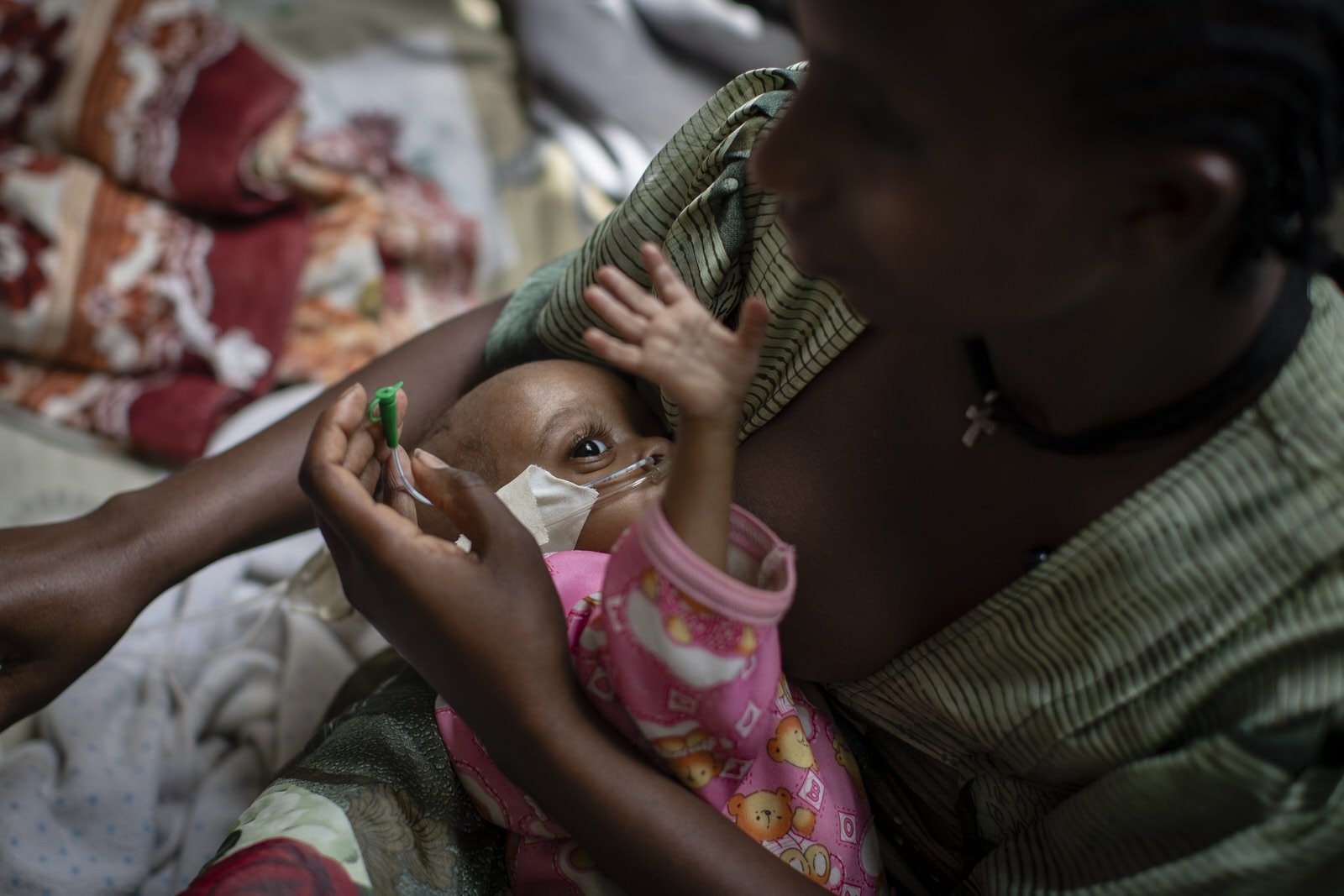
Birhan Etsana, 27, from Dengelat, uses a nasogastric tube to feed her malnourished baby, Mebrhit, who at 17 months old weighs just 5.2 kilograms (11 pounds and 7 ounces), at the Ayder Referral Hospital in Mekele, in the Tigray region of northern Ethiopia, on Monday, May 10, 2021. The lone survivor of her triplets, the infant was admitted with complications stemming from severe acute malnutrition, including heart failure. (AP Photo/Ben Curtis)
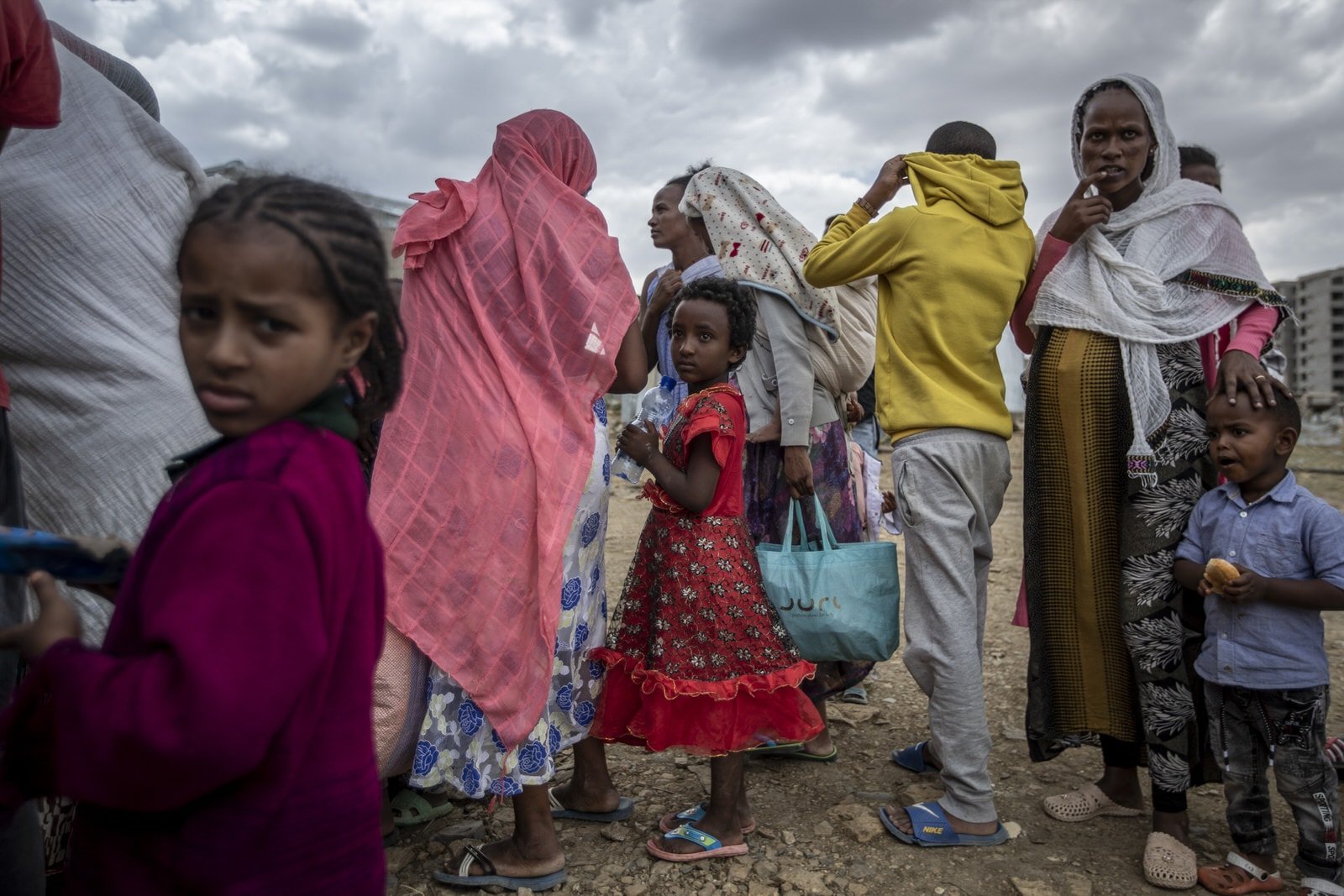
Elena, 7, center, stands in line with other displaced Tigrayans to receive food donated by local residents at a reception center for the internally displaced in Mekele, in the Tigray region of northern Ethiopia, on Sunday, May 9, 2021. In farming areas in Tigray to which The Associated Press got rare access, farmers, aid workers and local officials confirmed that food had been turned into a weapon of war. (AP Photo/Ben Curtis)







